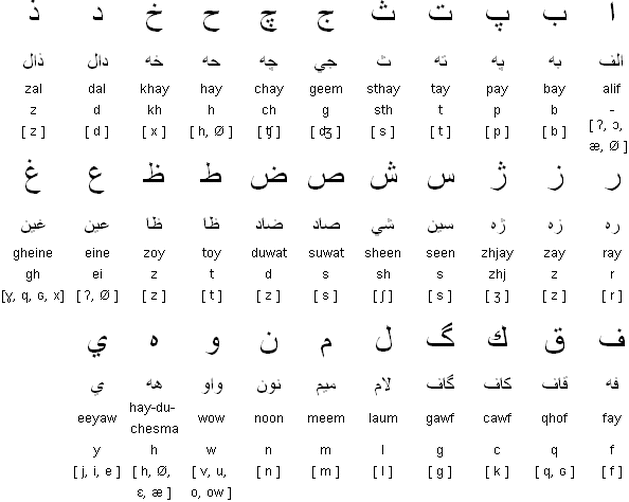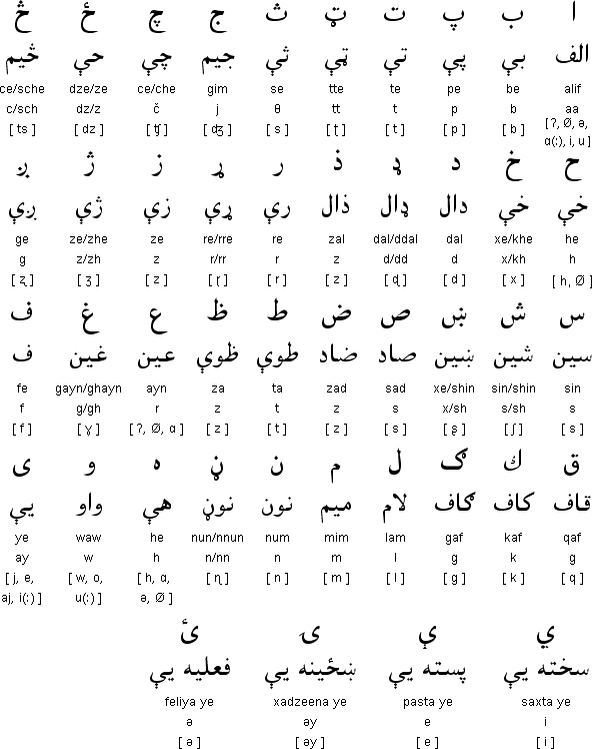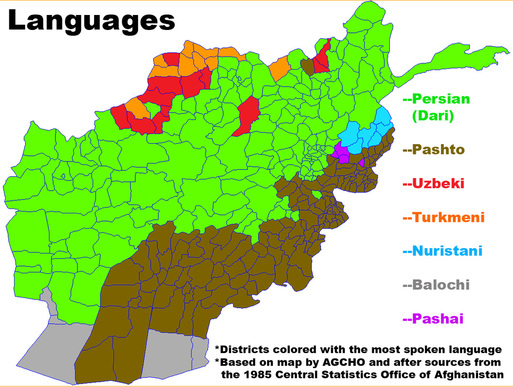Languages of Afghanistan
Table of Contents
I. Dari
A. Origins
1. Old/Early Dari
2. Middle Dari (Middle Persian)
3. Modern Dari
B. Alphabet & Numbers
C. Grammar
II. Pashto
A. Origins
B. Alphabet & Numbers
C. Grammar
III. Other languages
IV. References
A. Origins
1. Old/Early Dari
2. Middle Dari (Middle Persian)
3. Modern Dari
B. Alphabet & Numbers
C. Grammar
II. Pashto
A. Origins
B. Alphabet & Numbers
C. Grammar
III. Other languages
IV. References
I. Dari
Dari is known as a dialect of the Persian or Farsi languages, and is one of two official Afghani languages. 5 million people in Afghanistan speak Dari. It is the primary form of communication, i.e., radio broadcasts, business transactions, etc. (Qazi, n.d.). Dari uses a modified version of the Arabic alphabet, with four added letters. It is classified as an Indo-Iranian language, which is a subgroup of the Indo-European languages (Zwerdling, 2011). Dari is also used as a "lingua franca" among the different communities (Ager, 2011). A "lingua franca" is a language that is adopted as a common language between speakers with different native languages.
A. Origins
There were three phases in Dari development. The first phase was Old Dari, the second was Middle Dari, and the third was/is Modern Dari.
1. Old/Early Dari
Old Dari consisted of Old Persian and Old Avestan. These languages were spoken in ancient Bactria (Biruni, 2010). Avestan is now extinct, but can be found in the ancient Zoroastrianism, or Avesta, scriptures. Old Persian, however, survived through old writings, called Maikhi, dating back to between 550 and 330 B.C. ("Dari," 2011). It was during this period of time that Dari was selected as a lingua franca ("About Dari Language," 2000).
2. Middle Dari (Middle Persian)
From approximately 300 B.C. to 950 A.D., Old Persian morphed into Middle Persian. Middle Persian is related to several other languages, such as Parthian. Parthian had more complex grammar than Persian, and use of it went down substantially after the growth of Sassanian power. Middle Persian was spoken up until the conquest of the Arabs in the 7th century, after which it declined rapidly. Much of the writings from that time were destroyed (Biruni, 2010). Not much is known about Middle Persian because of this, except that it laid the foundations for Modern Farsi. Modern Farsi was developed during the 9th century, which then became the foundation for Modern Dari ("Dari," 2011).
3. Modern Dari
Modern Dari has much simpler grammar than its previous forms. It is also written in Arabic, with some added letters, and has been written this way since the Arab conquest in the 7th century. It has also expanded to contain a wide Arabic vocabulary (Biruni, 2010). Modern Dari is written with its letters connected, like cursive, and is read from right to left ("Dari," 2011).
B. Alphabet & Numbers
For an example of how to pronounce these syllables, visit this link to youtube: Dari Alphabet.
(Ager, 2011)
C. Grammar
Dari follows the formula SOV, or Subject-Object-Verb. Word modifiers, such as adjectives, follow the words they modify. However, spoken Dari relies on a system of suffixes and prefixes, and is more of a free-word-order language. There is no distinction of grammatical gender like French does. Dari also has no articles. Specified objects of a verb are marked with a verbal marker, though words with no marks represent a class of objects rather than a specific object. There are person and number - human or non-human, singular or plural - distinctions, and verbs must agree with the subject in person and number. Verbs can also change tense, and prepositions are used ("About Dari Language," 2000).
II. Pashto
Pashto is also known as Pashtu, Pushto, or Afghan ("Pashtu," 2011). Around 30 to 50 percent of Afghanistan's population speak Pashto as their first language, and between 10 and 27 percent speak it as their second language ("History of the Pashto Language," 2009). It has been the second official language of Afghanistan since 1936, though it has never achieved the higher business status of Dari (Robson, 2002). Even so, Pashto is the language taught in Afghani schools. It is classified as an Indo-Iranian language, like Dari, and it uses a modified Arabic alphabet (Qazi, n.d.). There are two main Pashto dialects: the harder, Northern one, and the softer, Southern one ("History of the Pashto Language," 2009). The Northern dialect is said to be harder because it uses harsher sounds, such as "kh" and "gh." On the other hand, the Southern dialect uses softer sounds like "sh" and "zh" ("Pashtu," 2011).
A. Origins
Pashto is said to be around 2,500 years old, but its first written form was seen in the 16th century, retelling the account of Shekh Mali's conquest of Swat. Then, in the 17th century, famous Afghani poets, such as Khushhal Khan Khattak, began writing in Pashto. This drove the language to expand even faster, and many new words were created ("History of Pashto Language," 2004). Pashto is technically not based on a previous language, but it does borrow words from multiple other languages, such as Avestan, Ossetic, Pamir, Arabic, Persian, and even English and French ("The History of the Pashto Language," 2009). Pashto has not seen many changes since the 19th century, as many of the grammatical guidelines are still in use from that period. Modern Pashto is written right to left, with most letters connected ("Overview of the Pashto Language," 2011).
B. Alphabet & Numbers
For an example of how to pronounce these syllables, visit this link to youtube: Pashto Alphabet.
(Ager, 2011)
C. Grammar
Pashto has some similarities to Dari, such as the sentence order of Subject-Object-Verb. Verbs must also agree with the person and number of the subject, just as they do in Dari. However, almost every other grammatical aspect is different. Pashto has three separate types of verbs, each with their own list of irregular verbs (Robson, 2002). The nouns must also change forms to show gender, unlike the nouns in Dari that need no gender specification. Pashto word modifiers, like adjectives, come before the words they modify. In addition to prepositions, there is also use of "postpositions." Postpositions follow whatever they are modifying/describing, as apposed to prepositions, which appear before ("Overview of the Pashto Language," 2011).
III. Other languages
Although there are two official languages of Afghanistan, there are at least 30 other languages spoken throughout the nation. All of them are regionally grouped. The amount of people speaking each language ranges anywhere from 200 people to 50 percent of the population. For a general idea of the layout of some of the different languages, look at the below map:
(Nielson, 2010)
IV. References
1.) About Dari Language (2000). In Motarjemin Group. Retrieved September 25, 2011, from http://www.motarjemin.com/translation_services/dari/about_dari_language.htm
2.) Ager, S. (2011, February). Dari. In Omniglot. Retrieved September 25, 2011, from http://www.omniglot.com/writing/dari.htm
3.) Biruni, A. R. (2010). Dari Language. In Khorasan Zameen. Retrieved September 25, 2011, from http://www.khorasanzameen.net/langs/dari.html
4.) Dari (2011). In Accredited. Retrieved September 25, 2011, from http://www.alsintl.com/resources/languages/Dari/
5.) The History of Pashto Language (2004). In Afghan Network. Retrieved September 25, 2011, from http://www.afghan-network.net/Ethnic-Groups/pashtu-history.html
6.) History of the Pashto Language (2009). In Outsourcing Translation. Retrieved September 25, 2011, from http://www.outsourcingtranslation.com/resources/history/pashto-language.php
7.) Nielson, P. I. (2010, January 14). The People and Cultures of Afghanistan. In Suite101. Retrieved September 25, 2011, from http://www.suite101.com/content/the-people-of-afghanistan-a189542
8.) Overview of the Pashto Language (2011). In Transparent Language. Retrieved September 25, 2011, from http://www.transparent.com/learn-pashto/overview.html
9.) Pashtu (2011). In Accredited. Retrieved September 25, 2011, from http://www.alsintl.com/resources/languages/Pashtu/
10.) Qazi, A. (n.d.). A Look at the Languages Spoken in Afghanistan. In Afghanistan Online. Retrieved September 22, 2011, from http://www.afghan-web.com/language/
11.) Robson, B., & Lipson, J. G. (2002, June 30). Language and Literacy. In Afghans: Their History and Culture. Retrieved September 22, 2011, from http://www.cal.org/co/afghan/alang.html
12.) Zwerdling, K., & Paltrow, T. (2011). Dari Langauge History. In Foreign Translations. Retrieved September 25, 2011, from http://www.foreigntranslations.com/languages/dari-translation/dari-language-history/
2.) Ager, S. (2011, February). Dari. In Omniglot. Retrieved September 25, 2011, from http://www.omniglot.com/writing/dari.htm
3.) Biruni, A. R. (2010). Dari Language. In Khorasan Zameen. Retrieved September 25, 2011, from http://www.khorasanzameen.net/langs/dari.html
4.) Dari (2011). In Accredited. Retrieved September 25, 2011, from http://www.alsintl.com/resources/languages/Dari/
5.) The History of Pashto Language (2004). In Afghan Network. Retrieved September 25, 2011, from http://www.afghan-network.net/Ethnic-Groups/pashtu-history.html
6.) History of the Pashto Language (2009). In Outsourcing Translation. Retrieved September 25, 2011, from http://www.outsourcingtranslation.com/resources/history/pashto-language.php
7.) Nielson, P. I. (2010, January 14). The People and Cultures of Afghanistan. In Suite101. Retrieved September 25, 2011, from http://www.suite101.com/content/the-people-of-afghanistan-a189542
8.) Overview of the Pashto Language (2011). In Transparent Language. Retrieved September 25, 2011, from http://www.transparent.com/learn-pashto/overview.html
9.) Pashtu (2011). In Accredited. Retrieved September 25, 2011, from http://www.alsintl.com/resources/languages/Pashtu/
10.) Qazi, A. (n.d.). A Look at the Languages Spoken in Afghanistan. In Afghanistan Online. Retrieved September 22, 2011, from http://www.afghan-web.com/language/
11.) Robson, B., & Lipson, J. G. (2002, June 30). Language and Literacy. In Afghans: Their History and Culture. Retrieved September 22, 2011, from http://www.cal.org/co/afghan/alang.html
12.) Zwerdling, K., & Paltrow, T. (2011). Dari Langauge History. In Foreign Translations. Retrieved September 25, 2011, from http://www.foreigntranslations.com/languages/dari-translation/dari-language-history/
This page was done by Cheyenne Kilian for Victoria Arthur's ISem 101.51, "War and Our World." Completed 9/26/2011.





